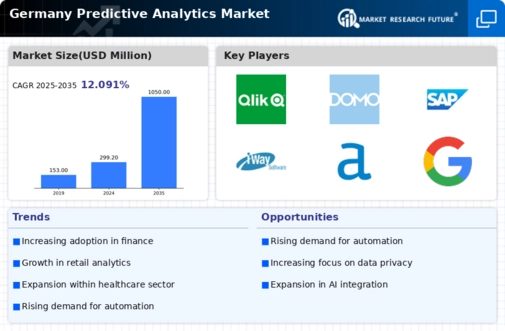Rising Importance of Customer Insights
Understanding customer behavior and preferences is increasingly vital for businesses in Germany, driving the demand for predictive analytics solutions. Organizations are leveraging analytics to gain insights into customer trends, enabling them to tailor products and services effectively. This trend is particularly pronounced in the retail and e-commerce sectors, where companies utilize predictive models to forecast purchasing behavior. As a result, the predictive analytics market is expected to grow by approximately 30% over the next five years, as businesses prioritize customer-centric strategies. This emphasis on customer insights highlights the transformative potential of predictive analytics in enhancing customer engagement and satisfaction.
Advancements in Technology Infrastructure
Technological advancements play a crucial role in shaping the predictive analytics market in Germany. The increasing availability of high-speed internet and cloud computing capabilities enables organizations to process and analyze large datasets efficiently. Furthermore, the integration of advanced technologies such as artificial intelligence and machine learning enhances the predictive capabilities of analytics tools. As of 2025, it is estimated that over 60% of businesses in Germany utilize cloud-based solutions for their analytics needs. This shift towards modern technology infrastructure not only streamlines data processing but also fosters innovation, thereby driving the growth of the predictive analytics market.
Regulatory Compliance and Risk Management
In Germany, regulatory compliance and risk management are paramount concerns for businesses, particularly in sectors such as finance and healthcare. The predictive analytics market benefits from this focus, as organizations utilize analytics tools to ensure compliance with stringent regulations and mitigate risks. By employing predictive models, companies can identify potential compliance issues before they arise, thus avoiding costly penalties. The market is expected to see a rise in demand for solutions that address these regulatory challenges, with an estimated growth rate of 20% in the next five years. This trend underscores the importance of predictive analytics in fostering a proactive approach to risk management.
Growing Demand for Data-Driven Decision Making
The predictive analytics market in Germany experiences a notable surge in demand as organizations increasingly recognize the value of data-driven decision making. Companies across various sectors, including finance, healthcare, and retail, are leveraging predictive analytics to enhance operational efficiency and improve customer experiences. According to recent estimates, the market is projected to grow at a CAGR of approximately 25% from 2025 to 2030. This growth is driven by the need for businesses to analyze vast amounts of data to forecast trends and make informed decisions. As organizations strive to remain competitive, the adoption of predictive analytics tools becomes essential, thereby propelling the market forward.
Increased Investment in Research and Development
Investment in research and development (R&D) is a significant driver of the predictive analytics market in Germany. Companies are allocating substantial resources to develop innovative analytics solutions that cater to evolving market needs. This investment is not only limited to technology firms but also spans various industries seeking to enhance their analytical capabilities. As of 2025, R&D spending in the analytics sector is projected to reach approximately €1 billion, reflecting a commitment to advancing predictive technologies. This focus on innovation is likely to yield new tools and methodologies, further propelling the growth of the predictive analytics market.

























Leave a Comment